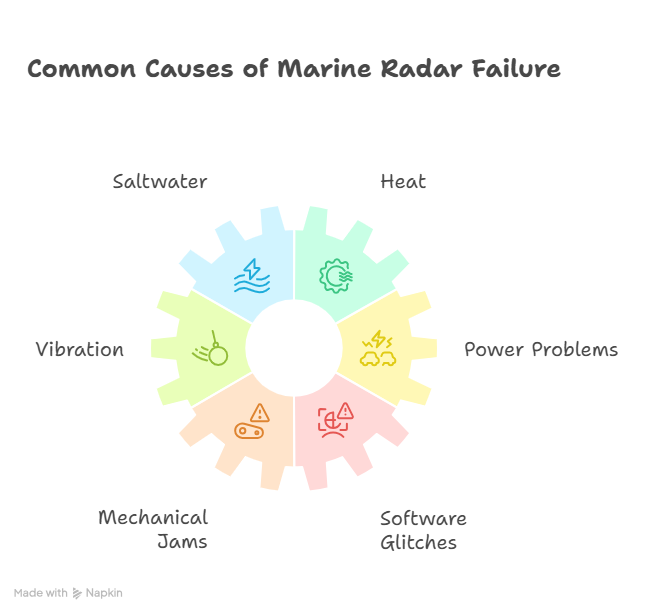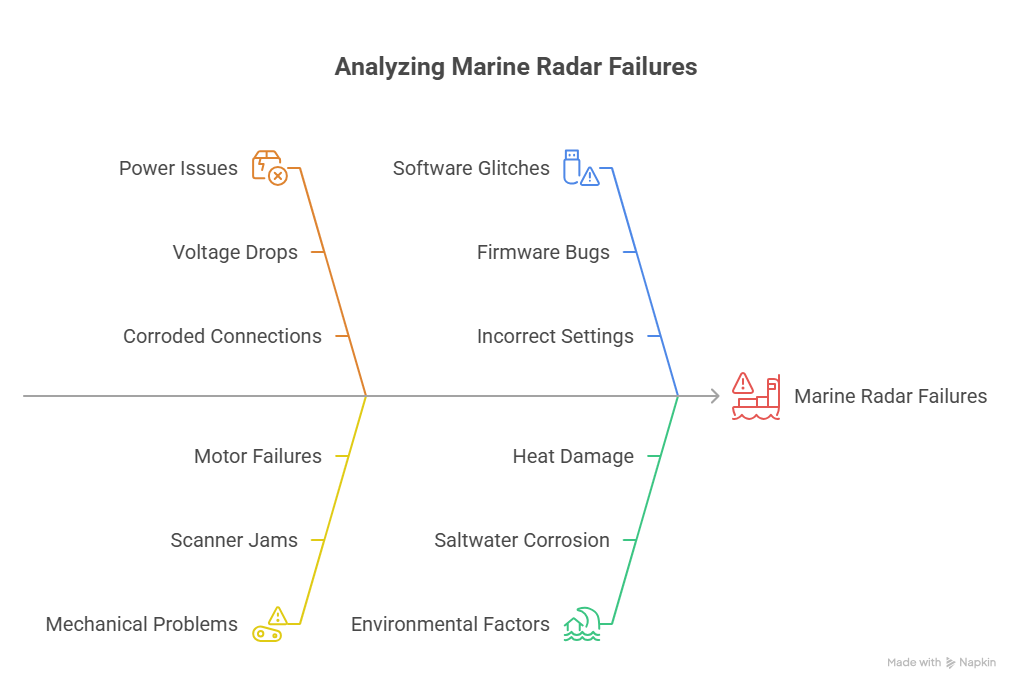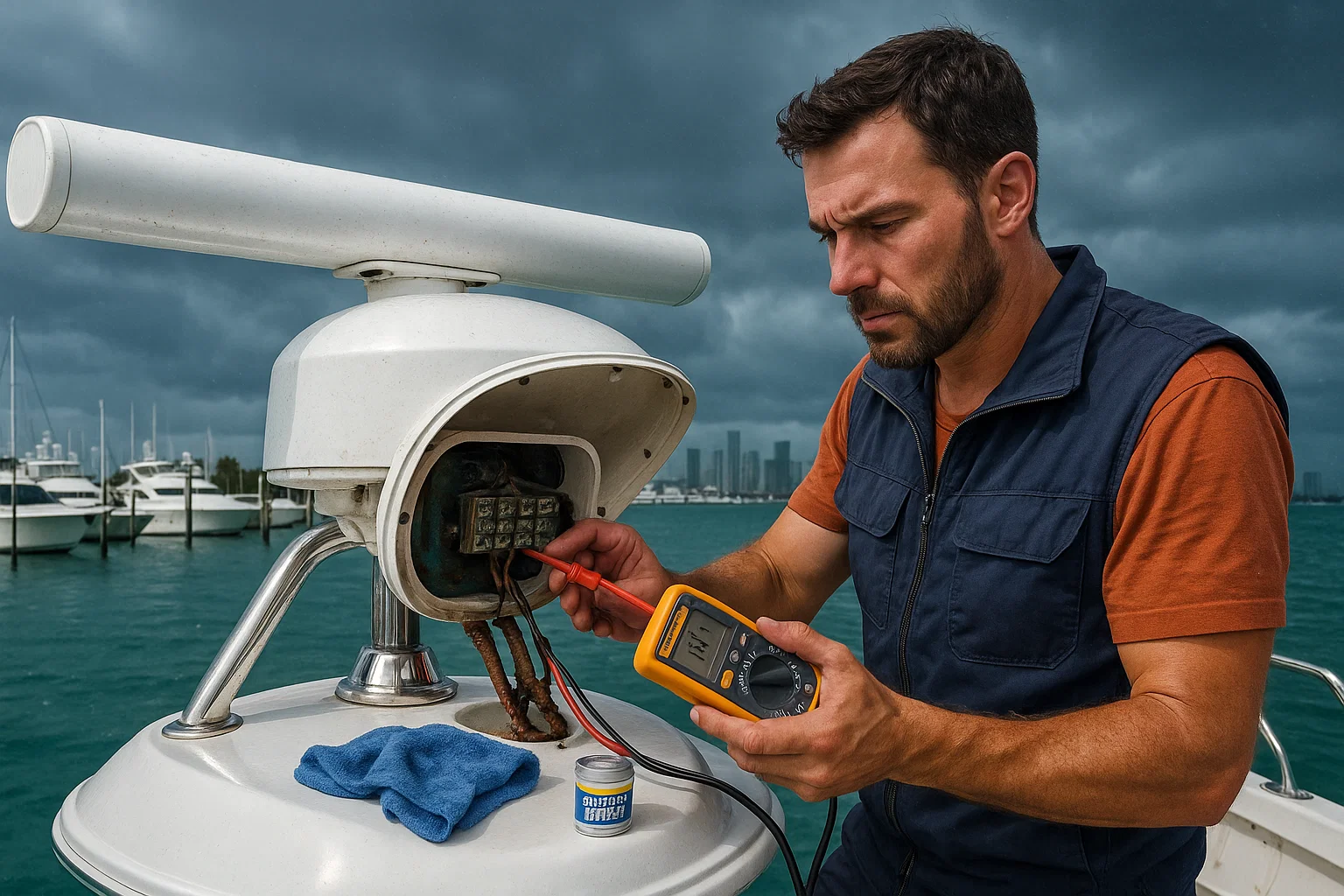Keeping Your Marine Radar Sharp: 15 Years of Fixes, Fumbles, and Lessons Learned
I’ve been tinkering with marine electronics in South Florida for 15 years, starting in my dad’s Fort Lauderdale garage and earning my ABYC Marine Electrical certification in 2010. Your radar’s your lifeline when fog rolls in off Key Biscayne or you’re dodging boats in a crowded Miami channel. When it goes down, it’s not just a hassle—it’s a safety issue. Last June 2024, a buddy named Javier at Dinner Key Marina had his Raymarine radar go blank during a stormy night. A quick voltage check with my Fluke multimeter showed 11.8 volts—too low for his unit’s 12.4-volt minimum. Fixed it for $100, but it could’ve been a $2,000 tow. Here’s my take on keeping your radar running, spotting problems early, and knowing when to call a pro.
Table of Contents
Why Do Marine Radars Fail?
Saltwater, heat, and vibration are brutal on electronics. I’ve seen everything from corroded cables to fried magnetrons. Most issues boil down to three things: power problems, mechanical jams, or software glitches. A client’s Furuno radar at Bahia Mar last summer stopped showing targets—turned out to be a seized motor in the scanner, costing $1,500 to fix. Catching these early saves you time, money, and stress on the water.

How Do I Spot Power Supply Issues?
Power’s the first thing I check—90% of radar failures I’ve seen in Miami trace back to voltage drops or bad connections. Most units need 12.4 volts minimum; anything less, and you’ll get errors or a blank screen. Last month, a guy at Stiltsville had his Garmin radar shut off mid-trip. I grabbed my Fluke 87V, checked the input, and found 11.9 volts due to a corroded terminal. A $50 fix, but it could’ve stranded him. Always start with a multimeter and clean connections with dielectric grease—it’s saved my bacon more than once.
What Causes Scanner and Antenna Problems?
The scanner’s the heart of your radar, spinning to send and receive signals. If it’s not moving, you’re blind. I’ve seen scanners jam from salt buildup or a bad motor. In July 2024, Maria at Coconut Grove called me when her Lowrance radar stopped rotating. I heard a grinding noise from the radome—classic sign of a seized bearing. A $600 repair, but waiting would’ve meant a $2,000 replacement. Listen for weird noises and check for obstructions like new rigging.
Why Is My Radar Screen Blank or Frozen?
A blank or frozen screen can feel like a disaster, but it’s often a simple fix. Sometimes it’s just a setting—last spring, a client at Key Biscayne thought his Simrad radar was dead, but it was in standby mode. I cycled it to “Transmit” (TX) mode, and boom, it worked. Other times, it’s a blown fuse or a software glitch. Power-cycling the unit fixes 30% of display issues I see. If that doesn’t work, it might be a deeper issue like a failing circuit board, which needs a pro.
How Can I Do a Quick DIY Radar Check?
Before you panic, run through my go-to checklist—it’s saved me hours on jobs. First, check voltage with a multimeter; anything below 12.4 volts spells trouble. Inspect fuses and breakers for signs of a short. Trace cables from the display to the scanner, looking for corrosion or loose plugs—South Florida’s humidity loves to eat wiring. Climb up and listen for the radome’s whir; if it’s silent, you’ve got a mechanical issue. Clean the antenna with isopropyl alcohol to clear salt buildup. This caught a $200 issue on a Sea Ray 350 last August before it became a $1,500 repair.
When Should I Call a Certified Technician?
Some problems are beyond DIY, and trust me, you don’t want to mess with high-voltage components. If your radar keeps glitching after a reboot or shows “ghost” targets that come and go, call a pro. I had a client at Fort Lauderdale’s Bahia Mar last year with a Raymarine unit showing intermittent targets—turned out to be a failing magnetron. A technician used a diagnostic scanner to confirm it, and the $1,200 repair included recalibration. Anything involving sealed casings or circuit boards needs a certified tech with brand-specific tools.
Why Is Magnetron Replacement a Pro Job?
The magnetron’s the radar’s pulse generator, and it wears out after 2,000–4,000 hours. Replacing it’s no joke—requires recalibrating the system to ensure accurate target ranges. I saw a DIY attempt go wrong on a Grady-White 208 in 2023; the guy botched the calibration, and his radar showed targets 500 yards off. Cost him $2,500 to fix what should’ve been $1,000. Leave magnetrons to pros with factory training—they’ve got the gear to get it right.

How Do Software Updates Help My Radar?
Modern radars are like computers—software bugs can cause freezes or bad data. Manufacturers like Raymarine or Furuno release firmware updates to fix these. I check their websites every spring for my clients’ units; a 2024 update for a Garmin radar I service fixed a glitch causing false targets. Skipping updates is like ignoring a check-engine light. It’s a 15-minute job that can save you a $500 service call.
What’s the Best Way to Maintain My Radar?
Preventive maintenance is your radar’s best friend. I schedule annual check-ups with a certified tech to test transmitter output and calibrate bearings—caught a 2-degree drift on a client’s Furuno last month. Clean cables with dielectric grease to fight corrosion; I do this every season on my Boston Whaler. Wipe the radome with mild soap to remove salt—takes 10 minutes and keeps signals clear. These habits have saved me from breakdowns in Miami’s brutal conditions.
How Much Does Radar Maintenance Cost?
Costs depend on the job. Routine maintenance—cleaning, voltage checks, software updates—runs $100–$300 a year. A full diagnostic check-up by a pro costs $200–$500 but catches issues early. Magnetron replacement or circuit board repairs can hit $1,000–$2,500, including calibration. I put this table together from jobs I’ve seen in South Florida:
| Service Type | Description | Average Cost | Availability |
|---|---|---|---|
| Routine Maintenance | Cleaning, voltage checks, software updates | $100–$300 | Most shops, mobile |
| Diagnostic Check-Up | Performance tests, bearing calibration | $200–$500 | Certified techs |
| Magnetron Replacement | Replacing pulse generator, recalibration | $1,000–$2,500 | Specialty shops |
| Emergency Repairs | On-dock fixes for sudden failures | $500–$2,000 | Mobile specialists |
FAQ: Common Marine Radar Questions
How Often Should I Check My Radar?
I recommend a quick DIY check—voltage, cables, settings—before every season, plus a professional tune-up yearly. Last summer, a $200 check-up caught a failing fuse on a client’s Simrad, saving a $1,500 repair. Use a multimeter and check the manufacturer’s site for updates.
What’s the Minimum Voltage for a Radar?
Most units need 12.4 volts. I’ve seen boats at Coconut Grove stall because of a 0.5-volt drop. Grab a Fluke multimeter to confirm; it’s a $50 tool that pays for itself.
Why Does My Radar Show Ghost Targets?
Intermittent targets often mean a failing magnetron or moisture in the scanner. I saw this on a Sea Ray 310 last July—$1,200 fix after a tech ran diagnostics. Don’t ignore it; call a pro with brand-specific scanners.
Can I Replace a Magnetron Myself?
Not a chance. It’s high-voltage and needs recalibration. A guy at Key Biscayne tried and botched his Furuno’s accuracy, costing $2,000 to fix. Certified techs have the tools to do it right.
How Do I Clean My Radar Antenna?
Use isopropyl alcohol or mild soap with a soft cloth—takes 10 minutes. I do this every season on my clients’ boats to clear salt buildup. Avoid harsh chemicals; they damage seals.
What’s a Professional Check-Up Include?
A tech tests transmitter output, receiver sensitivity, and bearing alignment. My go-to guy at Bahia Mar caught a gasket leak last year, saving a $1,000 repair. Costs $200–$500 but ensures safety.
Why Do Software Updates Matter?
Firmware fixes bugs and boosts performance. A 2024 Raymarine update I applied stopped false targets for a client. Check the manufacturer’s site twice a year—it’s free and takes 15 minutes.
How Do I Choose a Good Technician?
Look for ABYC or manufacturer certifications. Ask for diagnostic reports, not just invoices. I walked away from a shop in Fort Lauderdale that couldn’t show me error codes. Check Yelp or ask at marinas like Dinner Key.
Can I Fix a Frozen Radar Screen Myself?
Sometimes. Cycle to “Transmit” mode and reboot the unit—fixes 30% of issues I see. If it’s still frozen, like a client’s Lowrance last month, it might be a circuit board issue—call a pro.
What’s the Lifespan of a Radar Magnetron?
About 2,000–4,000 hours, depending on use. I’ve replaced magnetrons on older Furunos after three years in Miami’s heat. Track your hours in a logbook to plan ahead.
Why Proactive Maintenance Beats Repairs
Your radar’s your eyes in fog or at night. I learned this the hard way in 2012 when my own unit failed off Stiltsville—cost me $1,800 and a stressful tow. Now, I check voltage, clean cables, and update firmware every season. Schedule a $200–$500 annual check-up, and you’ll avoid most breakdowns. It’s not just about gear—it’s about knowing you can trust your system when the weather turns.
Author Bio
I’m Alex, a marine electronics technician with 15 years of experience in South Florida, ABYC-certified since 2010. I’ve serviced 300+ radar systems, from Raymarines to Furunos, across Miami and Fort Lauderdale. My work keeps boats safe at marinas like Dinner Key and Bahia Mar.


Leave a Reply